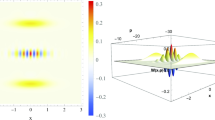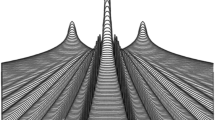Abstract
Quantum neural network filters for signal processing have received a lot of interest in the recent past. The implementations of these filters had a number of design parameters that led to numerical inefficiencies. At the same time the solution procedures employed were explicit in that the evolution of the time-varying functions had to be controlled. This often led to numerical instabilities. This paper outlines a procedure for improving the stability, numerical efficiency, and the accuracy of quantum neural network filters. Two examples are used to illustrate the principles employed.
Similar content being viewed by others
References
R. L. Dawes. Quantum Neurodynamics: Neural Stochastic Filtering with the Schrodinger Equation. In Proceedings of International Joint Conference on Neural Networks, Baltimore, USA, vol. 1, pp. 133–140, 1992.
R. L. Dawes. Quantum Neurodynamics and the Parametric Avalanche, Technical Report MRC-NASA-89004, Martingale Research Corporation, Allen, TX, USA, 1989.
R. L. Dawes. Quantum Neurodynamics: A new Neural Network Paradigm for Knowledge Representation, Cognition, and Control, Technical Report MRC-NSF-89003, Martingale Research Corporation, Allen, TX, USA, 1989.
R. L. Dawes. Adaptive Control and Stabilization with the Parametric Avalanche, Technical Report MRC-ARDEC-89002, Martingale Research Corporation, Allen, TX, USA, 1989.
D. Ventura, T. Martinez. Quantum Associative Memory with Exponential Capacity. In Proceedings of IEEE International Joint Conference on Computational Intelligence, IEEE Press, Anchorage, USA, vol. 1, pp. 509–513, 1998.
L. Behera, S. Bharat, S. Gaurav, A. Manish. A Recurrent Network model with Neurons Activated by Schroedinger Wave Equation and Its Application to Stochastic Filtering. In Proceedings of the 9th International Conference on High-performance Computing, Workshop on Soft Computing, Bangalore, India, 2002, [Online], Available: http://home.iitk.ac.in/:_lbehera/pub.html.
L. Behera, K. Indrani, A. C. Elitzur. Quantum Brain: A Recurrent Quantum Neural Network Model to Describe Eye Tracking of Moving Targets. Foundations of Physics Letters, vol. 18, no. 4, pp. 357–370, 2005.
L. Behera, K. Indrani, A. C. Elitzur. Adaptive Control of Robot Manipulators Using Quantum Neural Networks. In Proceedings of International Conference on Intelligent Signal Processing and Robotics, Allahabad, India, 2004, [Online], Available: http://home.iitk.ac.in/:_lbehera/pub.html
R. L. Dawes. Advances in the Theory of Quantum Neurodynamics, Rethinking Neural Networks: Quantum Fields and Biological Data. In Proceedings of the 1st Appalachian Conference on Behavioral Neurodynamics, Rethinking Neural Networks: Quantum Fields and Biological Data, K. H. Karl (ed.), Lawrence Erlbaum Associates, USA, pp. 149–159, 1993.
W. H. Press, S. A. Teukolsky, W. T. Vetterling, B. P. Flannery. Numerical Recipes in C: The Art of Scientific Computing, 2nd edition, Cambridge University Press, Cambridge, UK, 1992.
R. P. Feynman. Quantum Mechanical Computers. Foundation of Physics, vol. 16, no. 6, pp. 507–531, 1986, originally in Optics News, vol. 11, no. 2, pp. 11–20, 1985.
A. Goldberg, H. M. Schey, J. L. Schwartz. Computer-generated Motion Pictures of One-dimensional Quantum-mechanical Transmission and Reflection Phenomena. American Journal of Physics, vol. 35, no. 3, pp. 177–186, 1967.
Author information
Authors and Affiliations
Corresponding author
Additional information
W. U. Ahamed received his M. Sc. degree in applied mathematics from the University of Dhaka, Bangladesh, in 1991 and M. Sc. degree in mathematical finance from the University of Hull, England, in 2004. In 1991, he was a faculty member at the International University of Business Agriculture and Technology, Bangladesh, in 1995 at MARA Community College, Malaysia and in 1998 at University Tenaga National, Malaysia. Currently, he is a research student at the University of Hull, England.
His research interests include filtering theory and control system.
C. Kambhampati received his Ph.D. degree from City University, London, for his dissertation on algorithms for optimizing control in 1988. He currently is a reader at the Department of Computer Science at the University of Hull. Previous to this he held positions in the Department of Cybernetics, at the University of Reading, and the Department of Chemical and Process Engineering, at the University of Newcastle Upon Tyne. He has authored and co-authored over 100 papers on optimization, adaptive optimization, optimal control, neural networks, and fuzzy logic for control and robotics. He heads the Neural, Emergent and Agent Technologies (NEAT) Group. He is a member of IEEE and IEE.
His research interests include fault tolerant control, networked control systems, signal processing, neural networks, and multiagent systems.
Rights and permissions
About this article
Cite this article
Ahamed, W.U., Kambhampati, C. Stable quantum filters with scattering phenomena. Int. J. Autom. Comput. 5, 132–137 (2008). https://doi.org/10.1007/s11633-008-0132-x
Received:
Revised:
Published:
Issue Date:
DOI: https://doi.org/10.1007/s11633-008-0132-x




